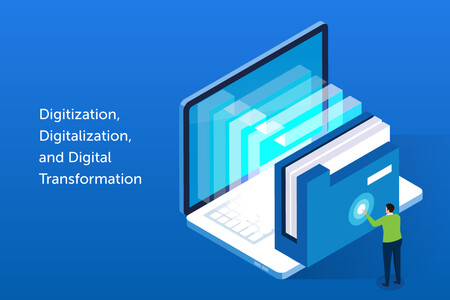As technology advances, the world is moving to a more digital environment. We often hear three different terms in this technological evolution: digitization, digitalization, and digital transformation.
In this article, we will differentiate these terms and identify the relationship of the three common concepts in workflow improvements.
What is digitization?
Digitization refers to the process of converting physical objects into digital format. An example of this would be document scanning, where text from physical paper is converted into PDF or other digital formats, which are then stored in the computer.
Digitization organizes information into units of data called bits. Analog information is encoded into zeroes and ones that computers can process, store, and transmit. The process of digitization is the backbone for data recording, making it an important aspect of digital technologies.
What is digitalization?
In digitization, physical objects or information are stored in computers, but the process where this data is used may not be changed. This is the key difference between digitization and digitalization. Through digitalization, digital technologies and digitized data are utilized to enable or improve processes.
While digitization focuses on converting and recording data, digitalization is all about developing processes and changing workflows to improve manual systems. An example of this would be using digitized customer data from different sources to automatically generate insights from their behaviour.
What is digital transformation?
Closely related to digitization and digitalization, digital transformation’s primary aim is to integrate technology to most, if not all, business operations. In digital transformation, digital technology is incorporated into all areas of the business to fundamentally improve efficiency in workflows and create value for customers. Cultural, organizational, and operational changes are implemented through the integration of digital technologies. Digital transformation allows businesses to adapt to ever-changing industry trends and landscapes.
Digitization vs. Digitalization vs. Digital Transformation
One may be easily confused with the meaning of digitization, digitalization, and digital transformation. However, these three concepts vary in different aspects such as their objectives and outcome.
Let us first discuss in terms of the purpose and outcome:
- Digitization’s purpose is to encode information in computers by converting from analog to digital format. The process mainly deals with recording data that can eventually be used in digital technologies.
- Digitalization deals with information processing, or how digitized data can be used to improve workflows through automating existing processes.
- Finally, digital transformation is all about leveraging knowledge and integrating it in all business areas to enhance engagement and create new value.
While not a linear process, digitization and digitalization serve as the path towards digital transformation. The highest level, digital transformation, begins with data that is encoded into the system (digitization), which is then used by the computer to enable or improve a process through digitalization. With the use of digital technologies and their integration in the entire organization workflow, digital transformation occurs.
These three concepts are crucial for organizations to adapt to the ever-changing business environment. In the next segment, we will discuss how each process could potentially benefit your business.
Digitalization in business
As defined earlier, digitalization leverages on digital technologies to improve process flows. In business, digitalization is used to accomplish various goals, such as increasing operational efficiency, reducing costs, minimizing human errors, and enabling data analysis. Businesses can create new revenues and value-producing opportunities through digitalization.
Such example can be seen in the banking industry. From requiring branch transactions to send money to other recipients, banks have developed online banking systems that allow real-time transfers without the need to go to the bank. One’s details in application forms are digitized and utilized to allow easy transfers within accounts. It allows easier workflows for both the organization and its clients, increasing efficiency in the business.
Digital transformation in business
The digital transformation trend has critically changed the way businesses operate. Digital transformation integrates digital technology in all areas of their business to improve or entirely create new value to their customers. Sometimes, new businesses are developed entirely from digital transformation. For instance, Spotify has removed the need for physically collecting CDs to have a music library. Now, with just a few clicks of a button, one can stream their favourite music anytime, anywhere.
An important aspect of digital transformation is that it can be unique for every organization. Businesses need to know what technology applies to them, choosing what areas they can optimize to drive growth.
Digitization in business
Digitization can be considered as the foundation for both digitalization and digital transformation. Businesses have adapted digitization techniques to improve how data can be used and processed. For instance, digitizing data through scanning paper-based customer application forms allow information to be stored in computers and eventually be processed to gain customer demographics and insights. Through digitization, businesses can transform data and leverage on it to enhance operations and revenues.
Digital solutions
As the world moves to more digital environments, various digital solutions have been developed. Digital solutions are created towards the goal of making systems more efficient for both customers and organizations. They promote convenience, reduced costs, and accuracy.
Common examples of digital solutions used in businesses include:
- Digital signing solutions that automate workflows and secure document signing.
- Cloud storage solutions that improve data management within the organizations.
- Digital communication solutions such as instant messaging and video conferencing.
- Customer relationship management solutions that help businesses improve client retention.
GlobalSign’s DSS
In a company’s journey towards digital transformation, it is important to employ solutions that would be useful to various stakeholders, from internal departments down to the clients. Digital Signing Solution (DSS) can be the first step in this process, being useful for document handling in human resources, finance, sales, and legal teams.
GlobalSign’s DSS can replace slow, paper-based document signing and deploy trusted digital signatures that not only promote convenience, but also security within the organization.
Say a customer from another country must sign a contract. There is no need for the traditional shipping method with the risk of tampering in between, as GlobalSign’s DSS can facilitate signing and ensure that the digital signature is from someone trusted. By using digital signatures with corresponding digital certificates, an organization’s workflow can be improved – saving on time and costs while ensuring the integrity of the document and meeting compliance requirements around digital signatures.
With digital signing solutions, businesses can ensure that their documents remain secure while improving the efficiency of workflow. GlobalSign is your partner towards the digital transformation of your business.
Explore the power of digital signatures with our free e-book. Download your copy today.







